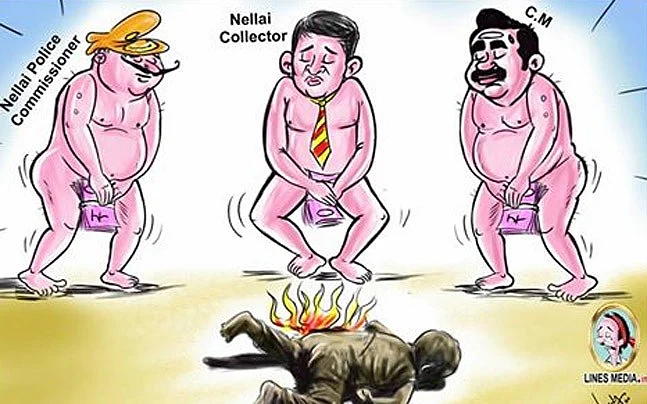The naked truth and the arrest of #CartoonistBala
The attitude of the Sangh Parivar in Karnataka and that of its ally, the AIADMK in Tamil Nadu, indicates a pattern of repression let loose against the media.
The arrest of cartoonist Bala from Tamil Nadu’s Tirunelveli district has sparked a fresh debate in political and media circles about freedom of speech and expression, and how far the media can go in exposing the apathy of officials and ministers.
Bala is not the first cartoonist to be arrested in Tamil Nadu. Nor will he be the last. The AIADMK government is besieged by memes, all-round criticism of its actions, and omissions and commissions. Frustrated over its inability to stem the rot, it has turned its ire towards media persons.
The issue snowballed following Bala’s caricature about the suicide of four family members due to the inaction on the part of Tirunelveli’s district collector regarding their complaint of usurious interest rates charged by private money-lenders and their harassment. The family members had set themselves on fire at the district collectorate, an incident which shook the government and the conscience of the people. More complaints poured in from several other districts about the harassment by these money-lenders, in clear violation of the rules.
Bala’s cartoon showed Tamil Nadu Chief Minister Edappadi K Palaniswami, Tirunelveli police commissioner Kapil Kumar Sarathkar and the district collector Sandeep Nanduri, naked, trying to cover their private parts with currency notes, standing idle, while a child was on fire, on October 23.

Nanduri lodged a complaint. Subsequently, Bala was arrested for depicting Palaniswami, Sarathkar and Nanduri in an “inappropriate” way in a cartoon. The arrest was for “awfully bad representation” of the chief minister and government officials by the cartoonist. “On his Facebook page, the cartoonist seemed to have boasted of his actions and I also received such cartoon image through WhatsApp about a week ago. Hence, I personally lodged the complaint with the police for action,” the collector said.
Superintendent of Police, P Arun Sakthi Kumar, said a case under Sections 67 of IT Act and 501 of IPC was booked on November 1, based on the collector’s complaint. Bala was arrested from his house in Chennai by a police team from Tirunelveli.
Before being produced in the court, Bala said he was upset on seeing two children burn at the Tirunelveli collectorate on October 23.
The incident had moved Bala. “It made me think that my children were burning. I am upset even now when I think about the incident. I have no words to express my sorrow. So I drew the cartoon out of rage. It was not aimed at anyone. If the collector is upset…I only expressed my views as a cartoonist,” Bala told media persons while he was being taken to the court.
With leaders of opposition parties and journalists condemning the arrest, Bala was released on bail the next day. However, the issue continues to arouse passion as there is a general atmosphere of violence and repression when it comes to tackling media persons and their right to freedom.
The killings of activists in Karnataka, especially writer Gauri Lankesh, and the action in another southern state of Tamil Nadu indicate a rise in levels of intolerance. The attitude of the Sangh Parivar in Karnataka and its ally, the AIADMK in Tamil Nadu, indicates a pattern of repression let loose against the media, say various organisations of journalists in Tamil Nadu.
Tamil Nadu has already witnessed the arrest of Balasubramaniam, editor of a leading Tamil magazine, Ananda Vikatan, during MGR’s rule in April 1987, as well as orders to arrest another journalist, KP Sunil over a privilege issue. Two leading journalists of The Hindu were sought to be arrested by the Jayalalithaa government, the police search even spreading to Bengaluru.
Not everyone is happy over the depiction of the chief minister, the police chief and the district collector in naked form, though the cartoonist might well have thought it was a case of naked abuse of power! There may have been a hint of obscenity here. The cartoon has been a big hit in the social media, with thousands of likes and shares. What the people enjoyed more was the depiction of the chief minister, the police chief and the collector covering their private parts with currency notes, a dig at corruption too.
The cartoonist’s sense of humour was not shared by the trio, leading to the arrest.
The issue of usurious rates charged by moneylenders and their nefarious practices has come to the foreground yet again, forcing the government to issue a statement that such practices were illegal.
A series of cartoons have lampooned the state government and the Centre over issues like GST and harassment by moneylenders, pushing the two ruling parties (allies) on to the back-foot in Tamil Nadu.
Cartoonists may well ask when painters have a licence to portray nudity, why not give such freedom to cartoonists as well! Paint all of us with the same brush, maybe their refrain. For the media, it is another case of Publish and be Damned.
